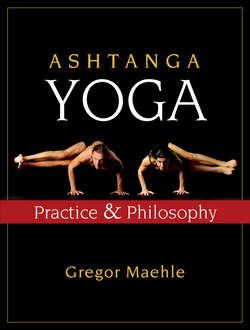Читать книгу Ashtanga Yoga - Gregor Maehle - Страница 19
На сайте Литреса книга снята с продажи.
Drishti
ОглавлениеWe move on now to drishti or focal point. As we have seen, the fifth limb of yoga is sense withdrawal (pratyahara). The Upanishads explain that the senses deliver the fuel for the mind in the form of sense objects. The mind then develops desires, which are the source of suffering. The mind’s basic concept is that we are lacking. This lack, according to the mind, can only be alleviated through a constant supply of stimulation from outside.
The concept of yoga, on the other hand, holds that we are always in the original and pristine state of bliss, which is consciousness. This original state is formless, however; and, since the mind has the tendency to attach itself to whatever comes along next, we forget our true nature. Sense withdrawal means to accept the fact that external stimuli can never truly fulfill us. Once that is accepted, we are free to realize that what we were desperately looking for on the outside was present inside all along. The Upanishads explain further that, as a fire dies down when the fuel is withheld, so the mind will return to its source when the fuel of the senses is withheld. The method — or rather the collection of methods — by which this can be brought about is sense withdrawal (pratyahara).
As has been explained, the withdrawal of the audio sense is brought about by listening to one’s own breath rather than to external sounds. The withdrawal or turning in of the visual sense is practiced through drishti, the attachment of one’s gaze to various focal points. These are:
• toward the nose
• toward the center of the forehead (third eye)
• toward the navel
• toward the hand
• toward the toes
• toward the side
• toward the thumb
• upward
By doing this, one prevents oneself from looking around, which would let the mind reach out. Following drishti, the practice becomes deeply internal and meditative.
Drishti is also a practice of concentration (dharana), the sixth of Patanjali’s limbs of yoga. If we practice in a distracted way, we may find ourselves listening to the birds outside and gazing around the room. To perform all of the prescribed actions — bandha, ujjayi, drishti, and finding proper alignment — the mind needs to be fully concentrated; otherwise one of the elements will miss out. In this way the practice provides us with constant feedback about whether we are in dharana. In time dharana will lead to meditation (dhyana).
Drishti has also a significant energetic aspect. According to the Yoga Yajnavalkya, which contains the yoga teachings of the sage Yajnavalkya, “One must endeavour to retain all the prana through the mind, in the navel, the tip of the nose and the big toes. Focussing at the tip of the nose is the means to mastery over prana. By focussing on the navel all diseases are removed. The body attains lightness by focussing on the big toes.”12 According to A. G. Mohan, a student of T. Krishnamacharya and translator of the Yoga Yajnavalkya, the aim of yoga is to concentrate the prana in the body, whereas it is usually scattered. A scattered prana will correspond to a scattered state of mind.
The scattered state of mind is called vikshipta in the Yoga Sutra. Prana that is drawn inward and concentrated in the body corresponds to the single-pointed (ekagra) and suspended (nirodha) states of mind, which lead to objective (samprajnata) and objectless (asamprajnata) samadhi. In the Ashtanga Vinyasa method, drishti is one of the vital techniques to draw the prana inward. Anyone who has practiced in front of a mirror may have noticed how looking into it draws awareness away from the core toward the surface. Exactly this happens to the flow of prana, which follows awareness. Practicing in front of a mirror might be helpful from time to time to check one’s alignment if no teacher is present, but it is preferable to develop proprioceptive awareness — awareness that does not depend on visual clues. This type of awareness draws prana inward, which corresponds to what the Upanishads call dissolving the mind into the heart. The permanent establishing of prana in the core of the body leads to samadhi or liberation.
As enthusiastic as some scriptures are about techniques like drishti, we have to remember we are still just operating within conditioned existence. The master Shankara reminds us: “Converting the ordinary vision into one of knowledge one should view the world as brahman (consciousness) itself. That is the noblest vision and not that which is directed to the tip of the nose.”13
